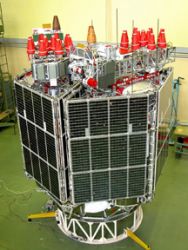Geometry-free combinations of measurements from the same satellite, such as (Φ1 − Φ2) or (P1 − P2), are used in today’s two-frequency GNSS to estimate variations of inter-frequency ionosphere delays. These combinations also contain information on multipath, which cannot be separated from ionosphere delays if only two frequencies are used.
Geometry-free combinations of measurements from the same satellite, such as (Φ1 − Φ2) or (P1 − P2), are used in today’s two-frequency GNSS to estimate variations of inter-frequency ionosphere delays. These combinations also contain information on multipath, which cannot be separated from ionosphere delays if only two frequencies are used.
If the measurements on a third frequency are available, these dual-frequency geometry-free combinations can be combined together to form triple-frequency geometry-free/iono-free combinations, which contain the superposition of multipath and tracking errors for the three frequencies, while ionosphere delays are canceled out.
These combinations can be formed for both phase and code measurements, but are particularly useful for phase. Firstly, phase multipath can be extracted from single-station raw measurement data; this task cannot be tackled with only two frequencies. Secondly, triple-frequency combinations of phase measurements are equal to corresponding linear combinations of phase ambiguities and, hence, can be used as constraints in ambiguity resolution algorithms.
In practice, this means that only ambiguities for the two frequencies are independent, while ambiguities on the other frequencies can be related to these two through simple linear formulas. The use of these constraints can reduce the number of independent ambiguities and improve the performance of multi-frequency ambiguity resolution algorithms.
Triple-frequency combinations of code measurements can be used in a similar manner to estimate code multipath and provide a relationship between timing group delays. Similarly to the case of phase ambiguities, timing group delays at any third frequency can be computed from raw range measurements based on the group delays for only two frequencies.
. . .
Closing Notes
It is well-known that the second frequency was introduced in GNSS so as to obtain real-time estimates of ionosphere delays. In an imaginary GNSS with no ionospheric effects on signal propagation, the second frequency would not provide any essential new information: it would only be useful as a source of additional data with independent multipath and tracking errors.
In ionosphere-free GNSS, the geometry-free combination would be constant and the relationship between ambiguities on the two frequencies becomes trivial.
The role of the third frequency in the future GNSS is comparable to that of the second frequency in an imaginary ionosphere-free GNSS. Because two frequencies are sufficient to estimate ionospheric errors, the third frequency does not add any new geometric information; it provides only an independent set of multipath and tracking errors.
Therefore, not surprisingly the measurements on the additional frequencies relate simply to the measurement on the two “basic” frequencies and include neither geometric nor ionospheric information. However, redundancy of observations, which comes with the use of additional frequencies, shall prove quite useful, especially combined with low-multipath characteristics of future Galileo signals.
Conclusions
In multi-frequency GNSS of the future triple-frequency, geometry-free/iono-free linear combinations of ranging measurements from the same satellite shall become available. These linear combinations contain superposition of multipath and tracking errors on the three frequencies; so, information on phase multipath shall become available through single-satellite single-station measurements. For code multipath this method also presents some advantages in addition to known techniques.
We have also seen that triple-frequency combinations of phase measurements can be translated into linear relationships between phase ambiguities, which can be used as constraints in ambiguity resolution algorithms. Ambiguities on any third frequency can be computed through these relationships if the ambiguities on the two frequencies are known.
This will lead to simplification and performance improvement of existing multi-frequency ambiguity resolution schemes. Similar relationships also exist between timing group delays for any trio of frequencies.
For the complete article, including figures, graphs, and images, please download the PDF of the article, above.
Acknowledgements
I am thankful to Frank Boon and Jean-Marie Sleewaegen, my colleagues at Septentrio, for useful discussions.





